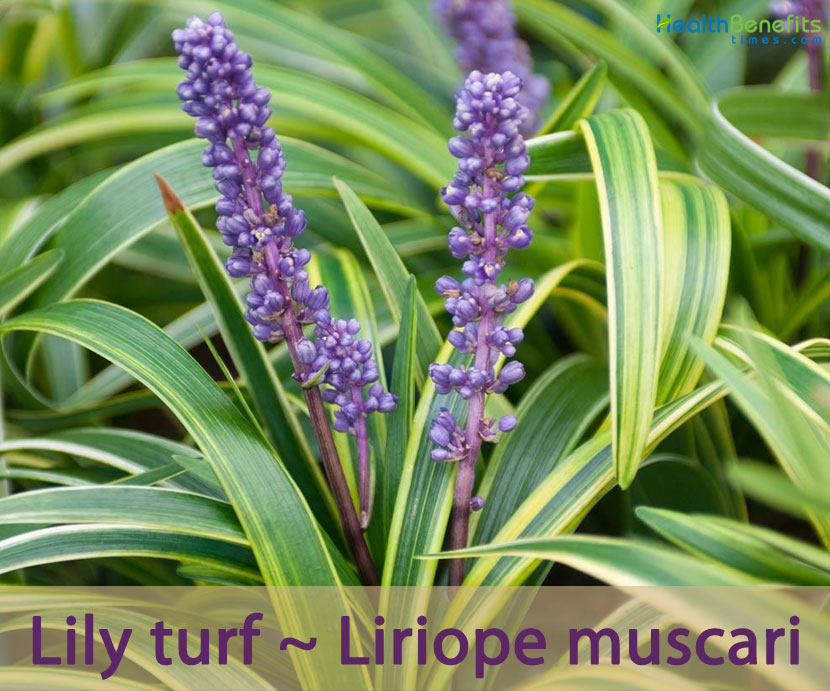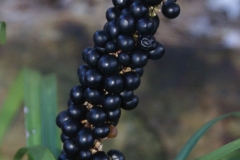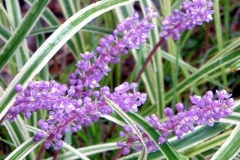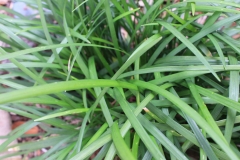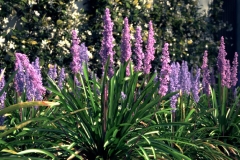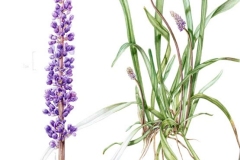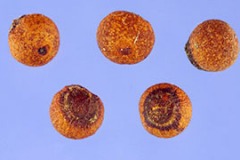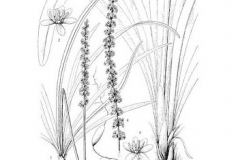| Lily turf Quick Facts | |
|---|---|
| Name: | Lily turf |
| Scientific Name: | Liriope muscari |
| Origin | Vietnam, Taiwan, China, Japan, and Korea |
| Colors | Green when young turning to blue ripening to black purple |
| Shapes | Spherical, berrylike drupes 0.2 to 0.3 inch (6 to 8 mm) wide |
| Health benefits | Support for coughs, fevers, dysentery, asthma, bronchial and lung inflammation |
| Name | Lily turf |
|---|---|
| Scientific Name | Liriope muscari |
| Native | Vietnam, Taiwan, China, Japan, and Korea |
| Common Names | Lilyturf, Big blue lilyturf, Border Grass, Blue Lilyturf, Liriope, monkey grass, Spider Grass, Border grass |
| Name in Other Languages | Afrikaans: Lilyturf Albanian: Lilyturf Amharic: Līlīwiteri (ሊሊውተር) Arabic: Lilyturf, liryubiat muskaria (ليريوبية موسكارية) Armenian: Shushan (շուշան) Azerbaijani: Lilyturf Bengali: Lilyturf Bulgarian: Liriopi (лириопи) Burmese: Naypyitaw (နေပြည်တော်) Chinese: Cǎopíng (草坪), kuo ye shan mai dong (阔叶山麦冬) Croatian: Lilyturf Czech: Lilyturf Danish: Lilyturf Dutch: Lilyturf, leliegras English: Lilyturf, Big blue Lilyturf, border grass, monkey grass Esperanto: Lililio Estonian: Lilyturf Filipino: Lilyturf Finnish: Lilyturf, Liriope French: Lilyturf, liriope muscari Georgian: Lilit’urpi (ლილიტურფი) German: Lilienrasen, Lilientraube, Traubenlilie Greek: Lílyrf (Λίλυρφ) Gujarati: Lilīṭarpha (લિલીટર્ફ) Hausa: Lilyturf Hebrew: לילית Hindi: Lilyturf Hungarian: Lilyturf Icelandic: Lilyturf Indonesian: Bunga bakung Irish: Lilyturf Italian: Lilyturf, liriope Japanese: Rirītāfu (リリーターフ), yabu-ran (ヤブラン) Javanese: Lilyturf Kannada: Liliṭarph (ಲಿಲಿಟರ್ಫ್) Kazakh: Liliturf (лилитурф) Korean: Baeghab (백합), maegmundong (맥문동), maek mun don Kurdish: Lilyturf Lao: Lilyturf Latin: Lilyturf Latvian: Lilyturf Lithuanian: Lilyturf Macedonian: Liliturf (лилитурф) Malagasy: Lilyturf Malay: Lilyturf Malayalam: Lilliṟṟarph (ലില്ലിറ്റർഫ്) Maltese: Lilyturf Marathi: Lileetarph (लिलीटर्फ) Mongolian: Liliurf (лилиурф) Nepali: Lileetarph (लिलीटर्फ) Norwegian: Lilyturf Oriya: ଲିଲିଟର୍ଫ୍ | Pashto: لیلیټرف Persian: لیلیتورف Polish: Lilyturf, liriope szafirkowata Portuguese: Lilyturf, Barba-de-serpente, Liriopes, Liríopes-verde, Ofiopogo-azul Punjabi: Lilyturf Romanian: Lilyturf Russian: Lilyturf , liriope muskari (лириопе мускари) Serbian: Lilyturf (лилитурф) Sindhi: لليٽرف Sinhala: Liliṭarf (ලිලිටර්ෆ්) Slovenian: Lilyturf Spanish: Lilyturf, liriope, serpentine Sudanese: Lilyturf Swedish: Lilyturf, Mörk druvlilja Tajik: Lilyturf Tamil: Liliṭṭarḥp (லிலிட்டர்ஃப்) Telugu: Lilyturf Thai: Lilyturf Turkish: Lilyturf Ukrainian: Lilyturf (лілітурф) Urdu: للیٹرف Uzbek: Lilyturf Vietnamese: Lướt ván Welsh: Lilyturf Zulu: Lilyturf |
| Plant Growth Habit | Small, broadleaf evergreen, clump-forming, herbaceous perennial plant |
| Growing Climates | Forests, bamboo forests, scrub, shady and moist places in ravines and on slopes |
| Soil | Tolerates a wide range of soils and soil conditions, but it doesn’t like constantly wet or boggy soil |
| Plant Size | 30–45 cm (12–18 in) tall |
| Root | The roots sometimes have a fleshy, tuberous part near their tip |
| Leaf | Leaves are tufted, numerous, ensiform, 45 to 70 centimeters long, and 0.3 to 0.8 centimeters wide |
| Flowering season | July-August |
| Flower | Multiple slender flower stalks, 15 to 14 inches (6 to 36 cm) tall, with the terminal 1.5 to 4.5 inches (4 to 12 cm) having spaced clusters of tiny lavender or violet (to white) flowers, with yellow centers, opening at different times above the leaves in late summer |
| Fruit Shape & Size | Spherical, berrylike drupes 0.2 to 0.3 inch (6 to 8 mm) wide |
| Fruit Color | Green when young turning to blue ripening to black purple |
| Seed | Blackish purple at maturity, globose, 6-7 mm in diameter |
| Plant Parts Used | Root |
| Propagation | By division of the clumps or by seed |
| Season | August to February |
| Types |
|
Plant Description
Lily turf is a small, broadleaf evergreen, clump-forming, herbaceous perennial plant that normally grows about 30–45 cm (12–18 in) tall. The plant is found growing in forests, bamboo forests, scrub, shady and moist places in ravines and on slopes. It tolerates a wide range of soils and soil conditions, but it doesn’t like constantly wet or boggy soil. Roots are fibrous, often with terminal tubers. Grass like tufts of initially interconnected plants lack a central stem, except for the flower/fruit stalks. The plant has clumps of strap-like, arching, glossy, dark green leaves (to 1″ wide). Clumps slowly expand by short stolons, but do not spread aggressively like Liriope spicata.
Leaves
Grass like but fleshier, radiating from the soil surface in expanding tufted groups, 2.5 to 7 inches (6 to 18 cm) long and 0.1 inch (2 mm) wide on new plants, up to 18 inches (45 cm) long and 0.4 inch (1 cm) wide on mature plants, widest at the middle and tapering to a blunt tip. Multiple lengthwise, parallel veins with a distinctly indented mid vein and slightly thickened, very finely serrated margins. It is glossy green being somewhat lighter beneath with whitish bases. Variegated varieties appear less aggressive. Leaf tips turn brown and die back in winter. New leaves grow from the base in spring.
| Leaf arrangement | Most emerge from the soil, usually without
a stem |
| Leaf type | Simple |
| Leaf margin | Entire |
| Leaf shape | Linear |
| Leaf venation | Parallel |
| Leaf type and persistence | Evergreen |
| Leaf blade length | 12 to 18 inches |
| Leaf color | Variegated |
| Fall color | No fall color change |
| Fall characteristic | Not showy |
Flowers
Multiple slender flower stalks, 15 to 14 inches (6 to 36 cm) tall, with the terminal 1.5 to 4.5 inches (4 to 12 cm) having spaced clusters of tiny lavender or violet (to white) flowers, with yellow centers, opening at different times above the leaves in late summer. Tepals are purple or lilac-purple, elliptic-oblong, 3.5-4 mm long and 1.5-1.8 mm wide. Flowering normally occurs in between July-August.
| Flower color | Lilac, purple |
| Flower characteristic | Summer flowering |
Fruit and seeds
Fertile flowers are followed by spherical, green, berrylike drupes turn blue ripening to black purple, 0.2 to 0.3 inch (6 to 8 mm) wide. Fruit has a grapelike skin and little to no pulp and contain a single spherical dark seed.
| Fruit shape | Round |
| Fruit length | Less than .5 inch |
| Fruit cover | Fleshy |
| Fruit color | Black |
| Fruit characteristic | Showy |
Cultivars
Listed below are some of the well-known cultivars of Lily turf
Big Blue lily-turf (Liriope muscari ‘Big Blue’)
It grows 12 to 18 inches tall and wide. It produces lavender to blue flowers. Although the hardiness zone is 5-10, it may need to be in a protected area in northern areas of zone 5.
Majestic lily-turf (Liriope muscari ‘Majestic’)
This cultivar grows 12 to 15 inches tall and wide. Its flowers are deep lavender to violet. Although the hardiness zone is 5-10, it may need to be in a protected area in northern areas of zone 5.
Monroe’s White lily-turf (Liriope muscari ‘Monroe’s White’)
It grows 14 to 18 inches tall and wide and produces white flowers. Although the hardiness zone is 5-10, it may need to be in a protected area in northern areas of zone 5.
Royal Purple lily-turf (Liriope muscari ‘Royal Purple’)
This cultivar grows 12 to 18 inches tall and wide and produces deep purple flowers. Although the hardiness zone is 5-10, it may need to be in a protected area in northern areas of zone 5.
Silvery Sunproof lily-turf (Liriope muscari ‘Silvery Sunproof’)
This has green leaves with cream-colored edges that grow nine to 15 inches tall and wide. Although the hardiness zone is 5-10, it may need to be in a protected area in northern areas of zone 5.
Traditional uses and benefits of Lilyturf
- Candied tubers can be eaten as tonic and aphrodisiac.
- In China, decoction of tubers is used to fortify the lungs, for coughs, fevers and dysentery.
- In Chinese traditional medicine, it is used for asthma, bronchial and lung inflammation.
- It is also used as tonic to moisten yin.
- The root is anti-inflammatory, anti-allergic, aphrodisiac, pectoral and stimulant.
- It is used as a tonic in Korea to increase stamina and also as an expectorant.
Other facts
- The roots, which often have fleshy tubers near their tip, are used in traditional Chinese medicine.
- It is a good drought tolerant evergreen ground cover plant.
- Plants should be spaced about 30 cm apart each way.
References:
http://www.hear.org/pier/species/liriope_muscari.htm
https://www.cabi.org/isc/datasheet/115335
https://www.missouribotanicalgarden.org/PlantFinder/PlantFinderDetails.aspx?kempercode=l100
https://www.itis.gov/servlet/SingleRpt/SingleRpt?search_topic=TSN&search_value=503501#null
https://en.wikipedia.org/wiki/Liriope_muscari
http://www.theplantlist.org/tpl1.1/record/kew-280317
http://www.stuartxchange.com/Lilyturf.html
https://pfaf.org/user/plant.aspx?latinname=Liriope+muscari
https://gd.eppo.int/taxon/LRIMU
http://www.flowersofindia.net/catalog/slides/Lily%20Turf.html
http://hort.ufl.edu/shrubs/LIRMUSA.PDF
https://plants.usda.gov/home/plantProfile?symbol=LIMU6


